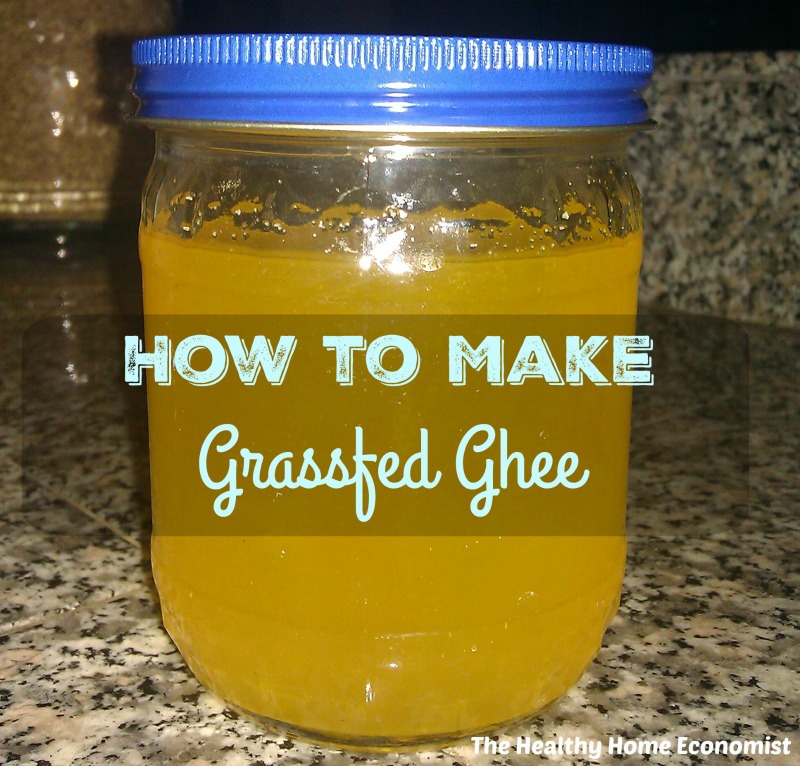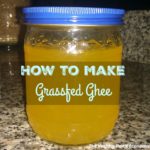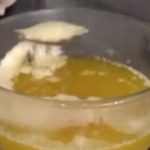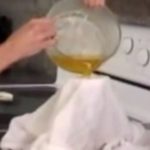Table of Contents[Hide][Show]
How to make homemade ghee on the stovetop quickly and easily for a healthy cooking fat that is shelf stable and nourishing.

Knowing how to make ghee is simply a must for any Traditional Cook. Clarified butter as it is also known, has been used for thousands of years by Indian cultures. In fact, traces of ghee have been found on fragments of Indian pottery dating as far back as 6500 BC!
When in a liquid state and made from unheated butter, ghee is called butter oil. Dr. Weston A. Price discovered that butter oil and cod liver oil work synergistically to supercharge absorption of Vitamins A, D, and K2 known as the X-factor.
Dr. Price always carried flasks of cod liver oil and butter oil to the bedside of very ill patients. More often than not, he was able to revive them with a few drops of each under the tongue. Using cod liver oil or butter oil separately did not have the same deathbed reviving effects.
Benefits of Ghee over Other Cooking Fats
It is best to know how to make clarified butter oil or ghee yourself rather than buying from the store. Notice the picture above of a jar that I made myself with pastured butter from a local farm. It is so yellow!
Commercial ghee from the store is a pale yellow, indicating lower nutritional value from cows eating grain mix instead of fresh green grass.
Ghee from the store is also ridiculously expensive, so learning to make it yourself is not only a more nutritious way to go, it is very cost-effective.
I make clarified butter oil for about half the cost of what it would be to buy it at the health food store.
Unlike butter, ghee does not need refrigeration and keeps well on the counter or pantry for many months. Keeping a jar in the pantry for a quick veggie saute is very convenient!
Another benefit of ghee is that it is easier to digest as all the milk solids (proteins) have been removed from the butter. Very frequently, even those with a true dairy allergy find that ghee presents no trouble for them.
Another advantage to using clarified butter instead of plain grass-fed butter is that the grassy taste and sometimes cheesy smell of the butter is eliminated.
Therefore, by learning to make clarified butter oil from grass-fed butter, you will find that you now have a healthy fat for cooking that does not displease your family with a cheesy odor. This can sometimes happen with grass-fed butter alone.
Homemade Grass-Fed Ghee
The recipe and video lesson below covers how to make this healthy and indispensable fat for use in your own kitchen.
I also cover how to make clarified butter capsules. This is a convenient way to take butter oil with your daily dose of cod liver oil.
If you are spending money on high vitamin cod liver oil (this is the brand I’ve used since 2015) it is a must to be taking it with clarified butter oil. This supercharges the beneficial effects!
Note that it is not advisable to make ghee from homemade raw butter. The heating process causes a loss of the enzyme and probiotics in this special food.
Prefer to Buy?
If after reviewing the recipe and video demo below you decide to buy instead, I would recommend this vetted source as a premier retailer of quality grass-fed ghee. Plain, cultured, and herb-flavored varieties are all available including a coconut oil/ghee blend.

How to Make Ghee
This simple recipe for making ghee can be accomplished on the stovetop in just a few minutes.
Ingredients
- 1 lb butter preferably grassfed and organic
- 1 wide mouthed mason jar quart size
- 1 cheesecloth fine mesh
- 1 funnel
Instructions
-
Place pound of butter in a medium sized pot or stove safe glass bowl. Turn heat on low and allow the butter to gently liquefy.
-
Turn heat to medium-low and gently remove foam that comes to the top of the melted butter with a slotted spoon.

-
After removing the foam, allow the melted butter to simmer on medium-low heat for 5-10 minutes longer to allow all the milk solids to settle out on the bottom of the bowl. You will know when the separation process is complete as the solids will be slightly brown on the bottom and the clarified butter will be completely clear and transparent.

-
Line a funnel placed into the open end of a wide mouthed mason jar with a fine mesh cheesecloth.
-
Pour the clarified butter into the funnel so that it is strained through the cheesecloth as it enters the mason jar.

-
Allow the finished ghee to cool in the mason jar. When room temperature, fasten the lid on tightly and store in the pantry as a convenient and incredibly healthy cooking oil for all your kitchen needs.








Thanks for your great video and tons of information. Trying to economize and making my own caps of CLO and now I can add butter to the list. brilliant ! Reading the comments were super helpful as well. Yes, you look radiant with beautiful skin.
Thanks.
Michelle
Video: How to Make Ghee (Butter Oil) – The Healthy Home Economist http://t.co/Z0BmEAwr
Butter oil is definitely NOT the same as ghee/clarified butter. The butter oil that Weston Price found so healing was made only from the milk of cows that had eaten a certain kind of grass early in the Spring. Summer and Fall grass did not produce the same nutrients, particularly a special factor that was a very specific form of Vitamin K. I am surprised no one has mentioned that here. Enormous oversight! I haven’t checked, but I would guess Green Pastures knows this and only uses butter that contains this special factor.
The Green pastures supplier told me butter oil is not the same as ghee/clarified butter?
Hi, I usually buy Organic Valley pastured butter. It is pasteurized and salted. is this okay to use for making ghee? The raw butter I can get here is 12 a pound the OV is $5.50. The pasteurization totally ruin it for making the ghee? thanks!
Hi Sarah,
I just recently found out how important Vit.K2 is and was wondering if K2 is in the butter oil that you make yourself like Ghee?
I ordered K2 supplements that are derived from soy but have since heard that the k2 in butter oil is much better for you. Any thoughts on this?
Is there a reason for using a glass bowl for heating the ghee? Would a regular pot damage the oil?
Hello Sarah
I was curious on how to give my kids the butter and cod liver oil? I have a 2 and 3 year old, and for me to give it to them on a spoon would probably make them gag! I already cook with the ghee, but I don’t think that would be enough. Any thoughts? Thanks!
I began using butter ghee and the kids don’t like the cheesy grass fed smell lol- however, I cook their eggs in it and then add a bit extra ghee in the bottom of the bowl or on the plate before I put the cooked eggs in/on and I mix it up. It disappears and they don’t seem to notice it at all lol!
Thank you Patience! For the cod liver oil I have been giving it to them in their juice. I usually make carrot juice and mix it in or I will use apple juice. They seem to not mind the taste. Lol!! Thanks again!
Thanks for this. With regards to the fish oil – I am keen to know your opinion of this product and whether it is ‘sufficient’?
usana BIOMEGA
http://www.usana.com/webhosting/vitalvits
I’ve looked for quality vitamins for a long time and am pleased to have found these as they come highly respected.
My area of interest right now is healing my own cavities that pregnancy and morning sickness have created!
Would love your feedback. Thanks
Hi Sarah, Ghee seems so easy to make! I can’t wait to try it! I enjoy watching your videos as well as do my daughters. I have been trying to find a good home economics course as I home school and want my girls to learn traditional methods of food preparation, but that type of educational material just isn’t in the home school catalogs. We just got done watching your kitchen equipment video and my three oldest ages 13-8 were totally engrossed and that gave me the idea to use your videos for our home ec!
There is a course I found just for that at the Food renegade website. Here’s the link
you may have to copy and paste. It’s specifically for home school 🙂